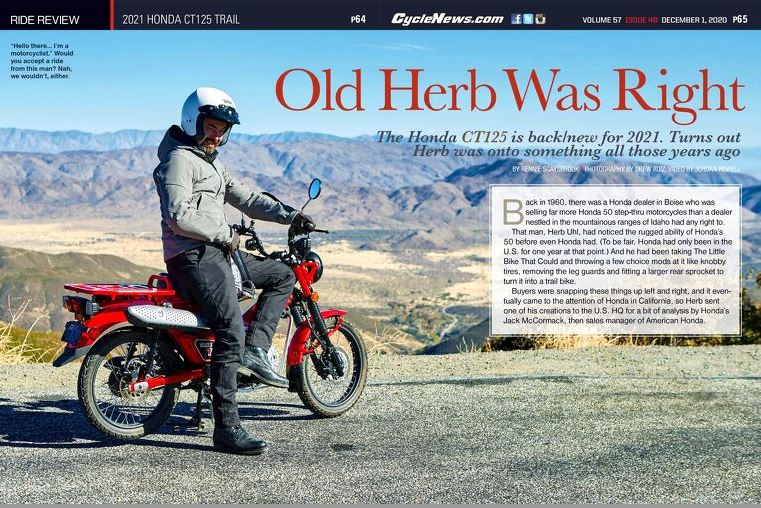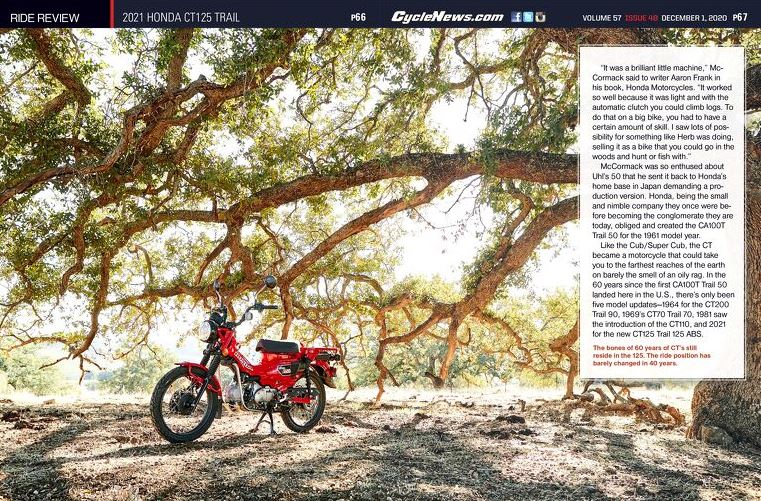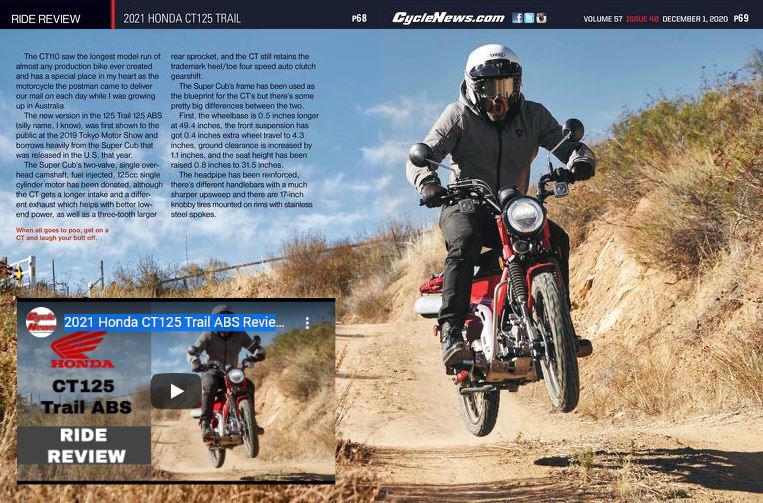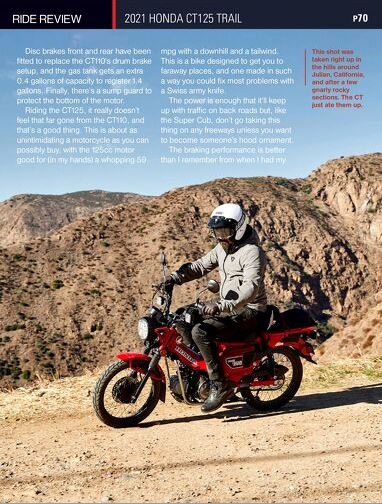The Honda CT125 is back/new for 2021. Turns out Herb was onto something all those years ago.
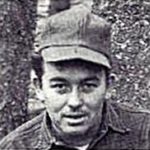
Back in 1960, there was a Honda dealer in Boise who was selling far more Honda 50 step-thru motorcycles than a dealer nestled in the mountainous ranges of Idaho had any right to.
That man, Herb Uhl, had noticed the rugged ability of Honda’s 50 before even Honda had. (To be fair, Honda had only been in the U.S. for one year at that point.) And he had been taking The Little Bike That Could and throwing a few choice mods at it, like knobby tires, removing the leg guards, and fitting a larger rear sprocket to turn it into a trail bike.
Buyers were snapping these things up left and right, and it eventually came to the attention of Honda in California, so Herb sent one of his creations to the U.S. HQ for a bit of analysis by Honda’s Jack McCormack, then sales manager of American Honda.
It was a brilliant little machine,” McCormack said to writer Aaron Frank in his book. Honda Motorcycles. “It worked so well because it was light and with the automatic clutch, you could climb logs. To do that on a big bike, you had to have a certain amount of skill. I saw lots of possibilities for something like Herb was doing, selling it as a bike that you could go in the woods and hunt or fish with.
McCormack was so enthused about Uhl’s 50 that he sent it back to Honda’s home base in Japan demanding a production version. Honda, being the small and nimble company they once were before becoming the conglomerate they are today, obliged and created the CA100T Trail 50 for the 1961 model year.
Like the Cun/SuperCub, the ST became a motorcycle that could take you to the farthest reaches of the earth on barely the smell of an old rag. In the 60 years since the first CA100T Trail 50 landed here in the U.S., there’s only been five model updates – 1964 for the CT200 Trail 90, 1969’s CT70 Trail 70, 1981 saw the introduction of the CT110, and 2021 for the new CT125 Trail 125 ABS.
The bones of 60 years of CT’s still reside in the 125. The ride position has barely changed in 40 years.
The CT110 saw the longest model run of almost any production bike ever created and has a special place in my heart as the motorcycle the postman came to deliver our mail on each day while I was growing up in Australia.
The new version in the 125 Trail 125 ABS (silly name, I know), was first shown to the public at the 2019 Tokyo Motor Show and borrows heavily from the Super Cub that was released in the U.S. that year.
The Super Cub’s two-valve, single overhead camshell, fuel-injected, 125cc single cylinder motor has been donated, although the CT gets a longer intake and a different exhaust which helps better low-end power, as well as a three-tooth larger rear sprocket, and the CT still retains the trademark heel/toe four-speed auto clutch gearshift.
The SuoerCub’s frame has been used as the blueprint for the CT’s but there’s some pretty big differences between the two.
First, the wheelbase is 0.5 inches longer at 19.4 inches, the front suspension has got 0.4 inches extra wheel travel to 4.3 inches, ground clearance is increased by 11 inches, and the seat height has been raised 0.9 inches to 31.5 inches.
The headpipe has been reinforced, there’s different handlebars with a much sharper upsweep and there are17-inch knobby tires mounted on rims with stainless steel spokes.
Disc brakes front and rear have been fitted to replace the CT110’s drum brake setup, and the gas tank gets an extra 0.4 gallons of capacity to register 1.4 gallons. Finally, there’s a step guard to protect the bottom of the motor.
Riding the CT125, it really doesn’t feel that far gone from the CT110, and that’s a good thing. This is about as unintimidating a motorcycle as you can possibly buy, with the 125cc motor good for (in my hands) a whopping 50 mpg with a downhill and a tailwind. This is a bike designed to get you to faraway places, and one made in such a way you could fix most problems with a Swiss army knife.
The power is enough that it keeps up with traffic on back roads but, like the Super Cub, don’t go taking this on any freeways unless you want to become someone’s hood ornament.
The braking performance is better than I remember from when I had my
Author: Rennie Scaysbrook
Source: Cycle News Volume 57 Issue 48 December 1, 2020

